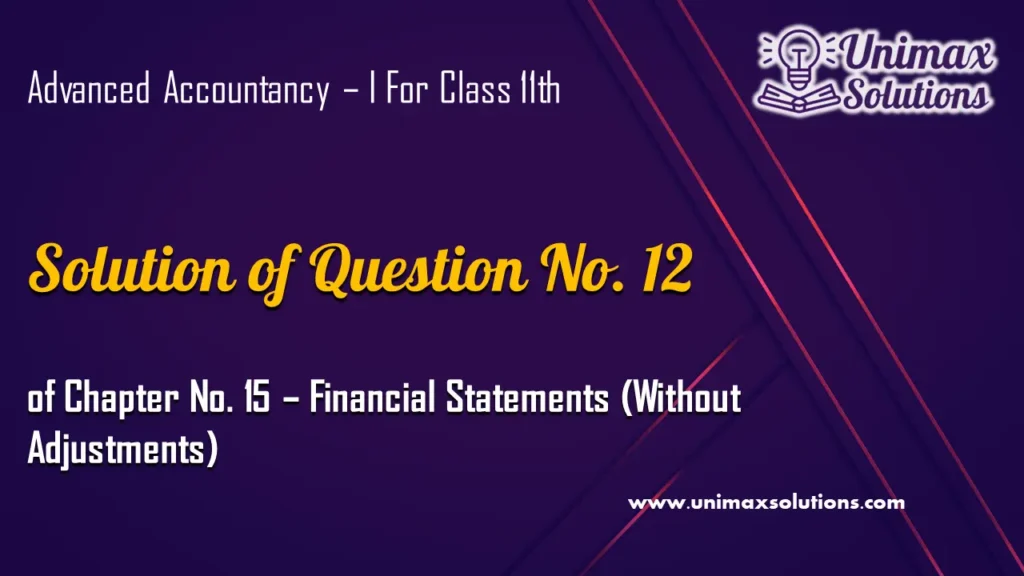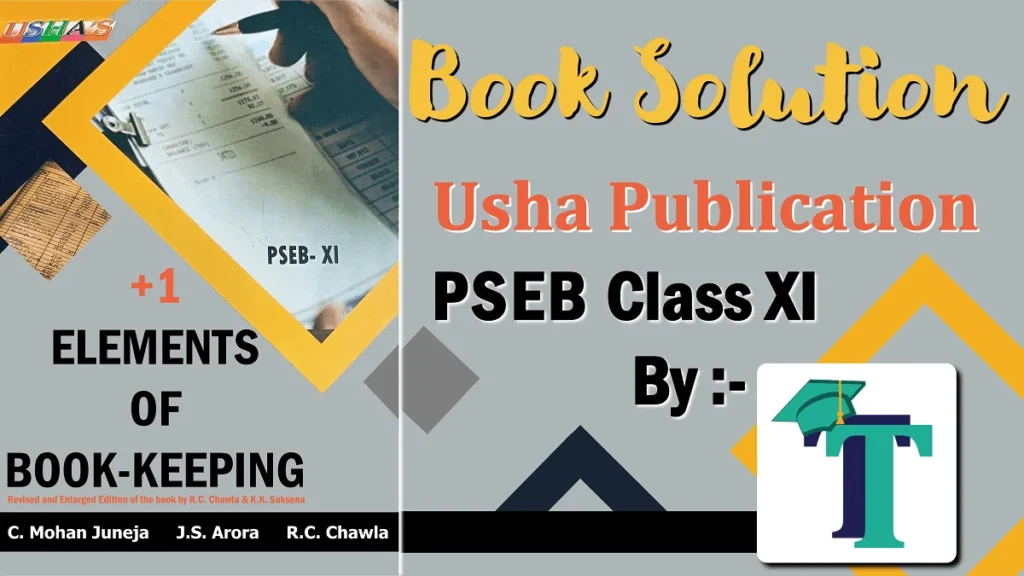
Advertisement
Question 12 Chapter 15 – Class 11 Unimax
From the following information, prepare the profit & loss account for the year ending on March 31,2020.
| ₹ | ₹ | ||
| Gross profit | 37,200 | Salaries & Wages | 12,000 |
| Discount received | 600 | Discount allowed | 1,200 |
| Interest on loan paid | 1,500 | Interest received | 1,800 |
| Commission received | 1,200 | Commission to sales men | 900 |
| Rent, Rate & Taxes paid | 2,400 | Rent received | 600 |
| Fire insurance premium | 2,160 | Carriage outward | 600 |
| Freight outward | 300 | Repairs & Maintenance | 360 |
| Printing & Stationery | 360 | Travelling expenses | 960 |
| Entertainment expenses | 720 | Water & electricity (indirect) | 720 |
| Postage & Telegram | 300 | Advertising & Publicity | 2,400 |
| Sales promotion expenses | 240 | Telephone expenses | 600 |
| Bad debts | 600 | Packing charges | 300 |
| Audit fees | 1,200 | Bank charges | 240 |
| Depreciation on furniture | Legal charges | 600 | |
| Sales office | 600 | Miscellaneous expenses | 600 |
| Administrative office | 1,200 | Loss on sales of fixed assets | 300 |
| Miscellaneous incomes | 1,200 | Loss by theft | 3,000 |
| Profit on sales of fixed assets | 5,100 | Dividend received on shares | 180 |
| Loss by fire | 600 | Income from investments | 120 |
| Loss by embezzlement | 600 |
The solution of Question 12 Chapter 15 – Class 11 Unimax
| Particular | Amount | Particular | Amount |
| To Interest on loan paid | 1,500 | By Gross Profit b/d | 37,200 |
| To Rent, Rate & Taxes | 2,400 | By Discount received | 600 |
| To Fire insurance premium | 2,160 | By Commission | 1,200 |
| To Printing & Stationery | 360 | By Miscellaneous incomes | 1,200 |
| To Entertainment expenses | 720 | By Profit on sales of fixed assets | 5,100 |
| To Postage & Telegram | 300 | By Interest | 1,800 |
| To Sales promotion expenses | 240 | By Rent received | 600 |
| To Bad debts | 600 | By Dividend received on shares | 180 |
| To Audit fees | 1,200 | By Income from investments | 120 |
| To Depreciation on furniture sales office | 600 | ||
| To Depreciation on furniture administrative office | 1,200 | ||
| To Loss by fire | 600 | ||
| To Loss by embezzlement | 600 | ||
| To Salaries & Wages | 12,000 | ||
| To Discount allowed | 1,200 | ||
| To Commission | 900 | ||
| To Carriage outward | 600 | ||
| To Repairs & Maintenance | 360 | ||
| To Travelling expenses | 960 | ||
| To Water & electricity | 720 | ||
| To Advertising & Publicity | 2,400 | ||
| To Freight outward | 300 | ||
| To Telephone expenses | 600 | ||
| To Packing charges | 300 | ||
| To Bank charges | 240 | ||
| To Legal charges | 600 | ||
| To Miscellaneous expenses | 600 | ||
| To Loss on sales of fixed assets | 300 | ||
| To Loss by theft | 3,000 | ||
| To Net Profit c/d (and transferred to capital a/c) | 10,440 | ||
| 48,000 | 48,000 |
End of Solution
Check Out the Solution of all questions for this chapter:
The solutions to all questions of Chapter 15 – Financial Statements (Without Adjustments) Unimax – Class 11 are shown as follows, click on the image of the question to get the solution.
Question 3 Chapter 15 – Class 11 Unimax
Advertisement
Question 8 Chapter 15 – Class 11 Unimax
Advertisement
Question 13 Chapter 15 – Class 11 Unimax
Advertisement
1. Comprehensive Solutions for All Chapters of Advanced Accountancy I Class 11 by Unimax
UnimaxSolutions.in offers a comprehensive solution for students studying Advanced Accountancy I Part 1 in Class 11. With their meticulously curated study material, students can access comprehensive solutions to all the questions included within each chapter. By selecting the chapter name from the study material, students can easily navigate through the topics and find detailed explanations and step-by-step solutions to the problems presented in that section. Whether it’s understanding complex accounting concepts, mastering calculation techniques, or analyzing financial statements, Unimax provides a valuable resource to aid students in their learning journey. With these comprehensive solutions at their disposal, students can enhance their understanding, clarify doubts, and improve their problem-solving skills in Advanced Accountancy, ensuring they are well-prepared for their Class 11 examinations.
- Chapter No. 1 – Introduction of Accounting
- Chapter No. 2 – Theory Base of Accounting
- Chapter No. 3 – Vouchers and Transactions
- Chapter No. 4 – Journal
- Chapter No. 5 – Goods and Services Tax (GST): An Introduction
- Chapter No. 6 – Ledger
- Chapter No. 7 – Special Purpose Book – Cash Book
- Chapter No. 8 – Other Subsidiary Books
- Chapter No. 9 – Trial Balance
- Chapter No. 10 – Rectification of Errors
- Chapter No. 11 – Depreciation
- Chapter No. 12 – Provision and Reserves
- Chapter No. 13 – Bank Reconciliation Statement
- Chapter No. 14 – Bills of Exchange
- Chapter No. 15 – Financial Statements (Without Adjustments)
- Chapter No. 16 – Financial Statements (With Adjustments)
- Chapter No. 17 – Accounts from Incomplete Records – Single Entry System
2. Punjab School Education Board (PSEB) Solutions of Usha Publication.
If you’re a student enrolled in the Punjab School Education Board Class 11, it’s essential to explore a wide range of books to cover the syllabus thoroughly. While the prescribed textbooks are undoubtedly valuable, supplementing your studies with additional resources can enhance your understanding and knowledge. Consider checking out other books that align with the curriculum, offering different perspectives and insights on the subjects you’re studying. These supplementary materials can provide you with alternative explanations, practice questions, and examples that may aid in clarifying complex concepts. Moreover, exploring diverse sources can expose you to a variety of writing styles and viewpoints, fostering a broader understanding of the subjects. So, seize the opportunity to expand your learning by delving into other books that can complement your studies and contribute to your academic growth.
Advertisement

